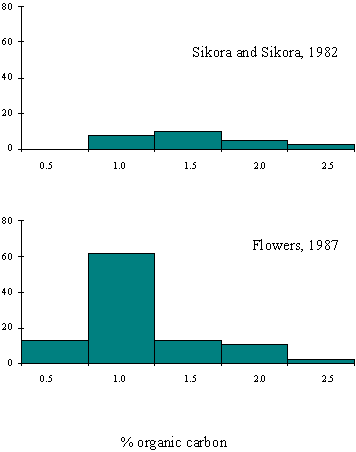
| Environmental Geochemistry and
Sediment Quality in Lake Pontchartrain |
III. Data and Preliminary Interpretations (con't)
B. Organic Carbon
| The distribution of organic carbon concentrations in the sediments is
shown in the histograms of Fig. 15, and the scaled-dot diagram (Fig. 16). A large, earlier study of Lake Pontchartrain
sediments, the raw data from which have not been found to date, is briefly summarized by
Steinmeyer (1939). These data reported "Organic matter" concentrations up to a
mean of 6.7% in the clays. However, these values were derived from ignition loss
determinations, rather than actually measuring organic carbon. As pointed out by Manheim
and others, 1997, such data include CaCO3 and much bound water loss during
heating of the clays. 
Figure 16 |
Figure 15

|
| Another extensive set of gridded data referred to by Tarver
and Savoie (1976) was not identified in terms of field location sufficient precision to
include in the database. The two data sets depicted in Fig. 15 show a smaller distribution
of organic carbon for the data of Flowers & Isphording, 1990) than for surface data of
Sikora and Sikora. The apparent discrepancy may be partly explained by the fact that the
Flowers & Isphording studies incorporated many more nearshore data, whereas the
studies of dredged areas in the central Lake may have encountered more fine-and
organic-rich sediments. Given the organic-rich swampy deposits surrounding Lakes
Pontchartrain and Maurepas it may seem surprising that the sediments do not contain more
organic carbon. This condition may be attributable to the relatively warm waters that help
ensure the breakdown of fresher planktonic organic matter into refractory organic
compounds that make up only a small fraction of the original material. Respiration and
consumption by bottom organisms is very efficient. |
|

